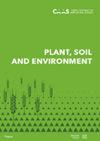Soil organic carbon characteristics affected by peanut shell biochar in saline-sodic paddy field
IF 1.8
3区 农林科学
Q1 AGRONOMY
引用次数: 1
Abstract
Biochar exhibits a profound impact on soil organic carbon (SOC) turnover and dynamics, but the underlying mechanism under field conditions is still unclear. A three-year field experiment was performed to evaluate the impact of peanut shell biochar applied at rates of 0, 33.75, 67.5, and 101.25 t/ha (referred to as B0, B1, B2, and B3, respectively) on SOC content and chemical composition in a saline-sodic paddy field using stable carbon isotope composition and 13C nuclear magnetic resonance technology. With increasing rates of biochar, SOC and aromatic carbon contents and alkyl carbon/oxygen-alkyl carbon and hydrophobic carbon/hydrophilic carbon ratios increased, while alkyl carbon and oxygen-alkyl carbon contents and aliphatic carbon/aromatic carbon ratio decreased. The new carbon from biochar and rice residues accounted for 26.5% of SOC under B0 and increased to above 80.0% under B2 and B3. The decay rate of old carbon was faster in biochar-amended than in unamended soil. SOC content was positively correlated with alkyl carbon/oxygen-alkyl carbon and hydrophobic carbon/hydrophilic carbon ratios but negatively correlated with aliphatic carbon/aromatic carbon ratio. The results suggest that biochar can increase SOC content by increasing its humification, aromaticity, and hydrophobicity. However, negative priming is not the main mechanism for SOC accumulation during the short-term period.花生壳生物炭对盐碱稻田土壤有机碳特性的影响
生物炭对土壤有机碳(SOC)的周转和动态有着深远的影响,但在田间条件下其潜在机制尚不清楚。采用稳定的碳同位素组成和13C核磁共振技术,对0、33.75、67.5和101.25 t/ha(分别称为B0、B1、B2和B3)施用花生壳生物炭对盐碱稻田SOC含量和化学成分的影响进行了为期三年的田间试验。随着生物炭用量的增加,SOC和芳香碳含量以及烷基碳/氧烷基碳和疏水碳/亲水碳的比例增加,而烷基碳和氧烷基碳含量以及脂族碳/芳香碳的比例降低。生物炭和水稻秸秆的新碳在B0下占SOC的26.5%,在B2和B3下增加到80.0%以上。改良后的生物炭比未改良的土壤中的老碳衰变速度更快。SOC含量与烷基碳/氧烷基碳和疏水碳/亲水碳的比例呈正相关,但与脂肪族碳/芳香族碳的比例呈负相关。结果表明,生物炭可以通过提高其腐殖化、芳香性和疏水性来提高SOC含量。然而,负启动并不是短期内SOC积累的主要机制。
本文章由计算机程序翻译,如有差异,请以英文原文为准。
求助全文
约1分钟内获得全文
求助全文
来源期刊

Plant, Soil and Environment
Agronomy, Soil Science-农艺学
CiteScore
4.80
自引率
4.20%
发文量
61
审稿时长
2.4 months
期刊介绍:
Experimental biology, agronomy, natural resources, and the environment; plant development, growth and productivity, breeding and seed production, growing of crops and their quality, soil care, conservation and productivity; agriculture and environment interactions from the perspective of sustainable development. Articles are published in English.
 求助内容:
求助内容: 应助结果提醒方式:
应助结果提醒方式:


